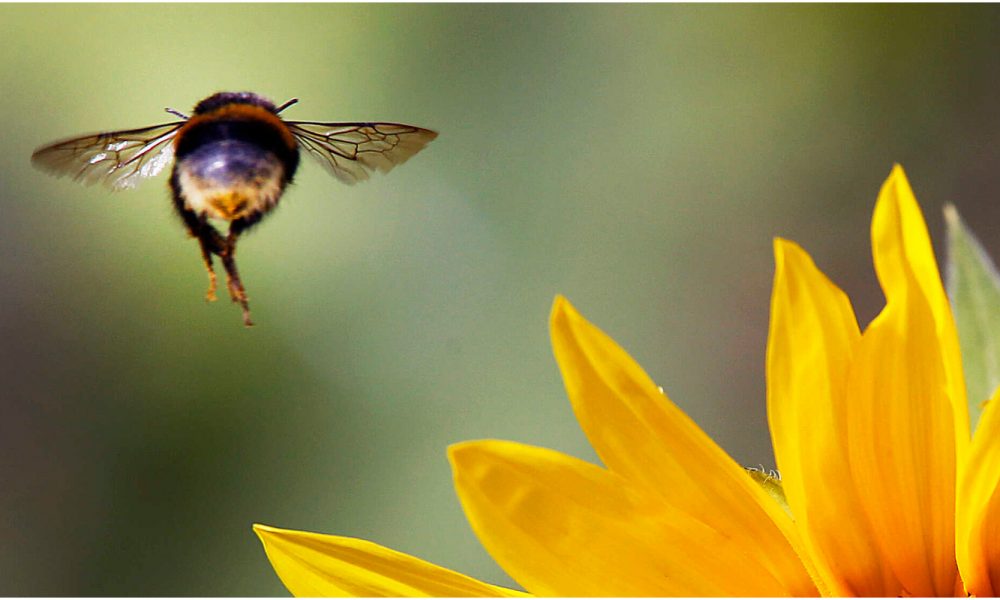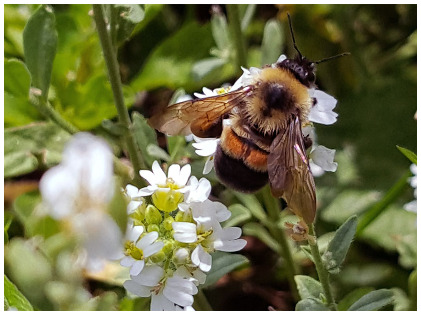
Bees Are More Than Just Cute Insects: We’d Cease To Exist Without Them!

The collapse of the world’s honeybee population has been a hot topic in environmental science in the current times. However, there is another bee population under threat and practically teetering towards extinction. You may not have heard of them, but the Bombus affinis is rusty patched bumblebees. They sure are as cute as their name suggests, too! The rusty patch bumblebees are everything you picture a bee to be in your childhood imagination – black and yellow and fat and fuzzy!
The Threats
 According to reports from the International Union for Conservation of Nature (IUCN) Red List that these sweet little bees, distinguished by a patch of rust-colored hair on its abdomen, is critically endangered. The cause of this is a commercial and residential development in this bee’s habitat, which pans the Midwestern US and the Northeastern US. Invasive species, as well as climate change, also account for the threat to this creature’s existence.
According to reports from the International Union for Conservation of Nature (IUCN) Red List that these sweet little bees, distinguished by a patch of rust-colored hair on its abdomen, is critically endangered. The cause of this is a commercial and residential development in this bee’s habitat, which pans the Midwestern US and the Northeastern US. Invasive species, as well as climate change, also account for the threat to this creature’s existence.
With the booming agriculture industry comes increases in pesticide use. When you spray crops, the chemicals harm the bees trying to build colonies around these fields. Pesticides that you might use in your gardens and the flower beds harm the bees too.
The Numbers Are Alarming
Since the year 2000, the rusty patched bee species has undergone a staggering decline of 87%. The population became the very first bumblebee species to appear on the list of endangered species. The IUCN suggests habitat protection and resource protection to help bring this bumblebee population into safe territory again. The legislation is now working to bolster this protection.
Minnesota state is heeding the advice of the IUCN, as in 2019, the state’s legislature passed a bill that implements a program that is titled ”Lawns to Legumes.” This program allocates $900K per year to compensate homeowners who offer their lawns up as bee-friendly habitats. You can achieve this by planting wildflowers, clovers, and species of native grasses that will attract bees.
The Rescue Plan
 Homeowners who have an interest in extending their lawns for saving the bees can apply for this program. Besides doing a good deed, they will also benefit from 75% of the costs being taken care of. Minnesota’s Board of Water and Soil Resources (BWSR) oversees the Land to Legumes grant program. Homeowners participating in the program receive a sign that marks their lawns as a home for pollinators.
Homeowners who have an interest in extending their lawns for saving the bees can apply for this program. Besides doing a good deed, they will also benefit from 75% of the costs being taken care of. Minnesota’s Board of Water and Soil Resources (BWSR) oversees the Land to Legumes grant program. Homeowners participating in the program receive a sign that marks their lawns as a home for pollinators.
This smart program opens up this spring, with 2020 seeing grants of up to $500. The residents who live in territories that are usually attractive to rusty patched bumblebees get these rewards. Similarly, the residents in other areas of Minnesota are eligible for up to $150 or even $350 basing on where they live.
Want to Join?
The suggestions that the program offers to homeowners interested in participating is to eliminate the use of harmful pesticides and to replace their lawns with no-mow varieties of grasses and groundcovers. The rusty patched bumblebee bee populations enjoy flowering species of plants and tall grass areas. They require safe regions to grow their colonies. It suggests that native flowers fill the garden beds and flowering shrubs and trees to surround the garden, like maple and dogwood. Only allowing perennial plants like white clover to grow at their leisure is a big help. That’s because around 55 and 350 bee species in Minnesota eat the Dutch clover. Hopefully, soon Minnesota’s lawns will be a buzzing playground for the humble bumblebees of the Bombus affinis species.
 While you may think that something like a bee colony is a trivial and unimportant matter, you couldn’t be further from the truth! The rusty patched bumblebees, in particular, are important pollinators. That’s because they contribute to food security and assist in the functioning of the entire ecosystem. They play a crucial role in the maintenance of healthy ecosystems. Their economic value is around $3 billion per annum in the US alone! And so these black and yellow, fat and fuzzy bumblebees are very important.
While you may think that something like a bee colony is a trivial and unimportant matter, you couldn’t be further from the truth! The rusty patched bumblebees, in particular, are important pollinators. That’s because they contribute to food security and assist in the functioning of the entire ecosystem. They play a crucial role in the maintenance of healthy ecosystems. Their economic value is around $3 billion per annum in the US alone! And so these black and yellow, fat and fuzzy bumblebees are very important.
We look forward to rapid improvement in these bees populations and range across Minnesota. Also, we hope to see other states follow suit and participate in the motion to save this bumblebee species! After all, the world is everyone’s to share, and only when humankind lets other beings thrive can there be real development.
More in Business & Investments
-
`
WWE SmackDown to Make a Comeback on USA Network in 2024
In a surprising twist, WWE’s Friday night staple, “SmackDown,” is bidding farewell to Fox and heading back to its old stomping...
November 24, 2023 -
`
Why Women Face Higher Out-of-Pocket Health Expenses
In healthcare, disparities persist, and a recent report from Deloitte underscores a significant financial gap between working women and men in...
November 18, 2023 -
`
Elon Musk vs Bill Gates: The Clash of Titans
In the realm of the world’s wealthiest individuals, a simmering rivalry has been captivating public attention. It’s not a clash of...
November 7, 2023 -
`
The Power Of Disconnecting
In our digitally driven age, where smartphones, tablets, and laptops have become extensions of ourselves, disconnecting might seem daunting. However, the...
October 31, 2023 -
`
JCPenney’s Bankruptcy: The End of an Era
JCPenney filed for bankruptcy in a move echoing the struggles of many retailers in the wake of the COVID-19 pandemic. This...
October 26, 2023 -
`
Reasons Why You Need a Financial Plan
Financial planning is not just for the wealthy or those nearing retirement. It’s a crucial tool for anyone seeking financial security...
October 19, 2023 -
`
How Brad Pitt Spends His Millions All Over the World
Brad Pitt, the charismatic Hollywood superstar, has left an indelible mark on the silver screen and made an impact in the...
October 10, 2023 -
`
Gen Z’s Posh Palate: The Unexpected Rise of Caviar Culture
Amid the backdrop of a digital era buzzing with viral dances, e-sports, and niche memes, there emerges a peculiar plot twist:...
October 7, 2023 -
`
Transform Your Retail Business With Social Media Mastery
If you’re a retail marketer posting your social media messages haphazardly, you might be missing out on prime opportunities to turn...
September 26, 2023















You must be logged in to post a comment Login